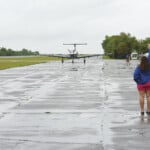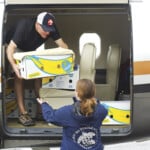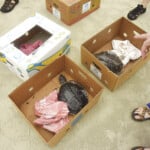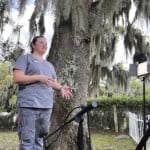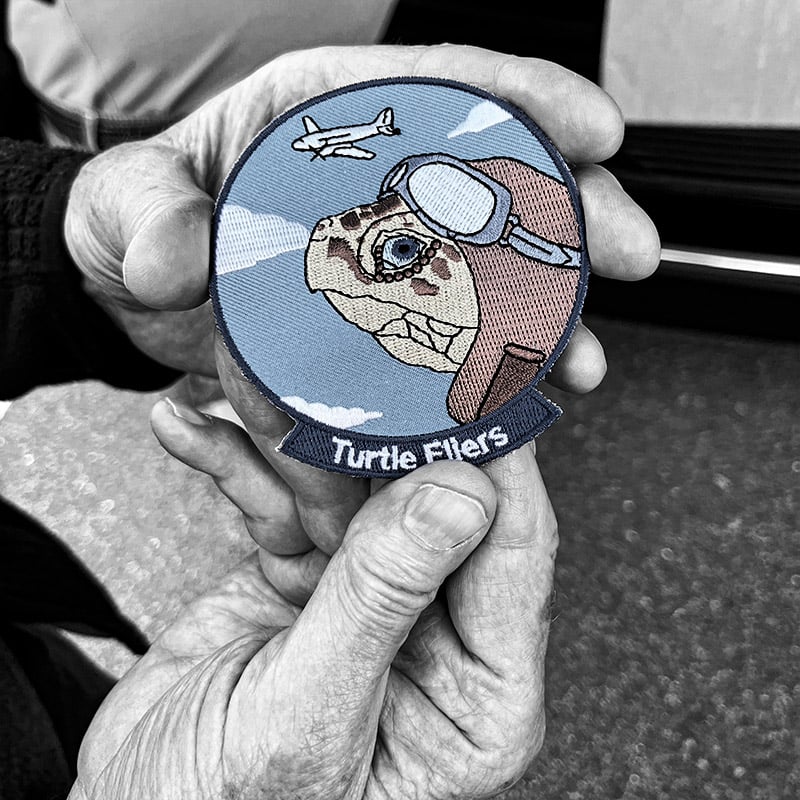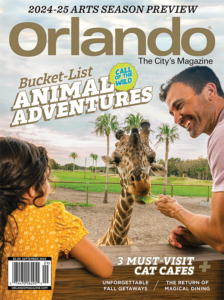Get To Know This High Flying Sea Turtle Rescue Operation
Cold-stunned turtles get some extra help from private airline pilots before heading to the sea on Jekyll Island.

Volunteers and Georgia Sea Turtle Center staff head to the ocean, four at a time, to release the turtles.
Oceanic Journey
All week I’d been patrolling the beach among several Loggerhead turtle nests due to erupt with 100 or more tiny hatchlings digging out and clambering down to the ocean.
My wife and I stood watch daily. But one evening while we broke to eat, the nest hatched. All that was left were tiny prints in the sand. So, we kept watch over another nest, swatting mosquitoes into the wee hours of the morning. Eventually, we had to go to bed back at the inn. That’s when this clutch of endangered turtles also hatched and disappeared into the surf.
Now we had to go home. I wrote a limerick to laugh off our disappointment.
We return to Pawleys every summer and every summer we visit that year’s nests, make inquiries about probable dates of hatches, and go home disappointed. Again.
But not this time.
Videographer Mark Albertin and I jumped on the road to Jekyll Island to document a turtle release organized by Turtles Fly Too (TF2 for short), an organization of about 500 private airplane pilots who volunteer their time, personal planes and fuel and maintenance costs to transport rescued turtles to safety.
Two planes, one from New England and the other from Long Island, were delivering 34 rescued turtles to Jekyll Island on April 3. These turtles, 33 of them Kemp’s Ridleys (the smallest and most endangered of all our sea turtles) had all been “cold-stunned”—lured by warming ocean temperatures, they had swum far north, then, when the weather turned, were stranded in frigid waters off the coast of Cape Cod and Long Island, their vital systems shutting down from hypothermia. But these had been rescued in time, carefully warmed, treated and rehabilitated in aquariums for several months. Now they were being returned to their native southern waters and released.
Jekyll Island, home of the Georgia Sea Turtle Center, was the perfect place. It’s the only education, rehabilitation and research facility in the state. The staff would oversee the release, the largest in the center’s 17-year history.
Mark and I met Leslie Weinstein for lunch the day before the scheduled release. He’s the founder and president of Turtles Fly Too. While we ate, he answered calls as he conferred with pilots, staff and the National Oceanic and Atmospheric Administration (NOAA).
Months of preparation hung in the balance and the weather prediction for the next day couldn’t have been worse. Volunteers had arrived from Florida, Georgia, South Carolina, Ohio and Colorado. The Georgia Department of Natural Resources had given its approval, and the staff of the center was ready to go.
In the meantime, Mark and I made our way to the center to tour the displays and visit the tanks where 18 injured sea turtles—green turtles, Loggerheads and Kemp’s Ridleys—were being rehabilitated.
“Sea turtles are a great health indicator for our oceans,” explains Rachel Obermeyer, the center’s rehabilitation program manager. “If the turtles aren’t doing well, the things they depend on aren’t doing well either … it’s a trickling effect. It’s really important to help care for them, because if one piece of that puzzle goes missing, you kind of have a whole collapse, and we definitely don’t want that.”
While all our sea turtle species are endangered, conservation efforts since legal protection came in 1978 seem to be working. Turtle Exclusion Devices (TEDs) are required by law on the nets of all commercial shrimp trawlers, saving thousands of turtles from drowning. Turtle nests are protected and monitored. “Over the past 30 to 40 years, we’ve seen a slow but steady increase in our nesting population,” says Davide Zeigler, the center’s research program manager. In fact, the Nature Conservancy reports that Georgia had a record 4,071 nests laid along its coastline in 2022—11 times the number 18 years earlier. Amazing numbers, given the odds, since Loggerhead hatchlings have a one-in-1000 chance of surviving into adulthood. The lucky female who beats the odds won’t return to lay eggs for at least 25 years.
“We take turtles all the way to the tip of florida and out to texas. And then when they have a clean bill of health, we pick them up and we return them to the ocean.”
—Leslie Weinstein, founder and president of Turtles Fly Too
But the Kemp’s Ridleys are not doing so well. They nest in Mexico where protection, at best, is iffy. Weinstein fears the species is headed for extinction, so he started TF2 in 2014 when 50 turtles needed rescue. As president of True-Lock, which makes aviation fasteners, he knew lots of pilots. He made some calls, got some volunteers —he calls them turtle fliers— and founded Turtles Fly Too soon after. It’s now a 501(c)(3) non-profit organization with almost 500 turtle fliers.
“We’re the ones that handle all the transports of these turtles and permits and everything else,” Weinstein says. “We have transported right around 5,000 turtles of the Kemp’s species, and they are the most endangered of all. We take turtles all the way to the tip of Florida and out to Texas. And then when they have a clean bill of health, we pick them up and we return them to the ocean.”
And if these TF2 pilots don’t do it, no one will. “The government, the U.S. Fish and Wildlife Service and NOAA do not have what it takes to do what we’re doing,” Weinstein explains. “It’s way more complicated than getting some turtles and putting them on an airplane.” Even though TF2 performs a vital service for these agencies, it gets no funding from them. That’s why TF2 relies on volunteers and donors. The IRS lets donors write off their donations over 15 years.
Release Day
It’s pouring the next morning. Our mood is dark. But when Mark and I catch Weinstein at breakfast, he’s beaming. It’s on! The pilots report they can evade the storms. They are ready to load the turtles and fly them south.
At about 3 p.m., Mark and I head out to Jekyll’s grassy little airport to wait. Two vans from the center are waiting, too, along with a bunch of past turtle fliers who are there to help. Soon the first plane drops below the clouds, then the second plane lands. The cabins of both are stacked high with cardboard boxes, each one containing a turtle. The boxes are rushed to the vans, and we head to the water as quickly as possible.
An excited crowd waits quietly on the beach along with TV cameras and reporters as the center staff and TF2 volunteers in a long line carry the 34 boxes to the edge of the water. After giving instructions, the staff members take the volunteers, four at a time, into the quiet ocean water.
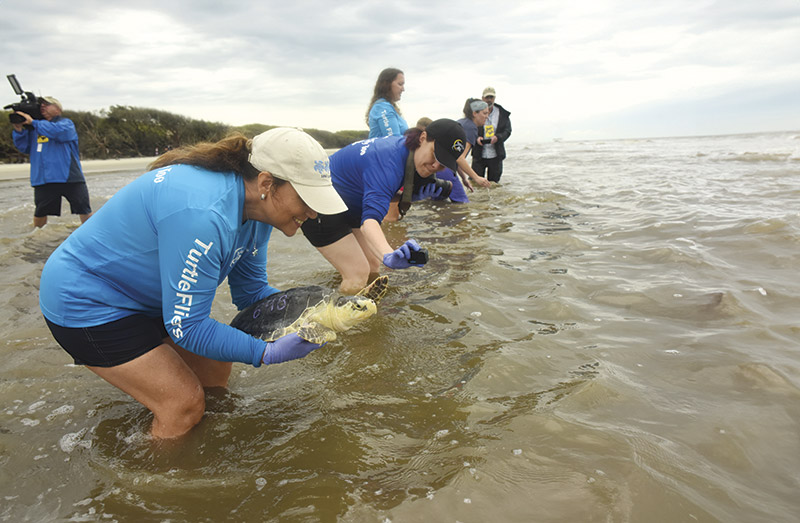
Volunteers from Florida, Georgia, South Carolina, Ohio and Colorado release turtles back into the sea on Jekyll Island, supervised by Georgia Sea Turtle Center staff.
Mark and I had been watching, filming, thrilled to see the turtles slip into the water and swim away. Then someone asks me, “Would you like to carry a turtle?”
Would I? I have dreamed of this for more than 20 years! I put on a pair of rubber gloves, walk over to a box and look down on a Kemp’s Ridley with the number 62 painted on his carapace. “Hello, 62,” I say, picking him up. He pokes his head way forward, straining toward the water, and his long front flippers reach out and stroke as if he’s swimming through the air. I follow a turtle staffer out into water up to my knees, bend over and let him go.
He’s gone in a flash.
